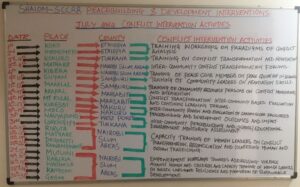(Shalom-SCCRR Department of Research
Director: Prof. W. K. Omoka.
The voice of Peace Practitioners and Researchers)
CLIMATE CHANGE, LAKE TURKANA AND INTER-COMMUNAL CONFLICTS IN THE ILEMI TRIANGLE REGION: A CRITICAL ANALYSIS. {© 2020 Shalom-SCCRR}*
By Paulson Erot, MA
(Peer-reviewed by Prof. W. K. Omoka, Rev. Dr. Patrick Devine, and Shalom-SCCRR Dept. of Research)
“Saving our planet, lifting people out of poverty, advancing economic growth… these are one and the same fight. We must connect the dots between climate change, water scarcity, energy shortages, global health, food security, and women’s empowerment. Solutions to one problem must be solutions for all.” Ban Ki-moon, the 8th Secretary-General of the United Nations (2007 – 2016).
Introduction
Climate change is one of the greatest challenges facing humankind in the 21st Century. While there is a prolonged debate on whether climate change is caused by human activities (such as burning of fossils) or by natural processes (such fluctuations in the sun’s heat and ocean currents), evidence is now overwhelmingly convincing that climate change is unequivocal and happening at unprecedented rate (IPCC, 2018; Huang et al., 2016; Adhikari et al., 2015).
In the African context, the severity of the effects of climate change are particularly being experienced in Arid and Semi-Arid rangelands which cover nearly two thirds of the continent (Herrero et al. 2016). Most of these areas are inhabited by an estimated 386 million people and majority of them are pastoralist communities who depend on natural resources (mainly water and pasture) for their livelihoods (Adhikari et al., 2015; Conway & Schipper, 2011).
Violent inter-communal conflict among the pastoralist communities is not a new phenomenon; it has occurred for centuries. However, there are a number of factors that explain the recent increase in conflict among these communities, the main ones being competition over natural resources, subsequent reduction in pastoral land and proliferation of modern arms (Shalom-SCCRR, 2019; Adano et al., 2012). According to Devine (2009), there are four major underlying causes of conflict among the pastoralist communities: competition for environmental resources (water and pasture); contested territory/boundaries; cultural variations; and, state neglect manifested in the lack of essential institutions that would help the communities in meeting their basic human needs and actualize their potential. These underlying causes and related issues, to a large extent, are still embedded in pastoralist conflicts in the IGAD region.
Although there are a myriad of factors that contribute to inter-communal conflicts among the pastoralist communities, the central aim of this paper is to examine the interplay between climate change and inter-communal conflict among the pastoralist communities in the context of the Ilemi Triangle region.
Dynamics of climate change in the Ilemi Triangle region
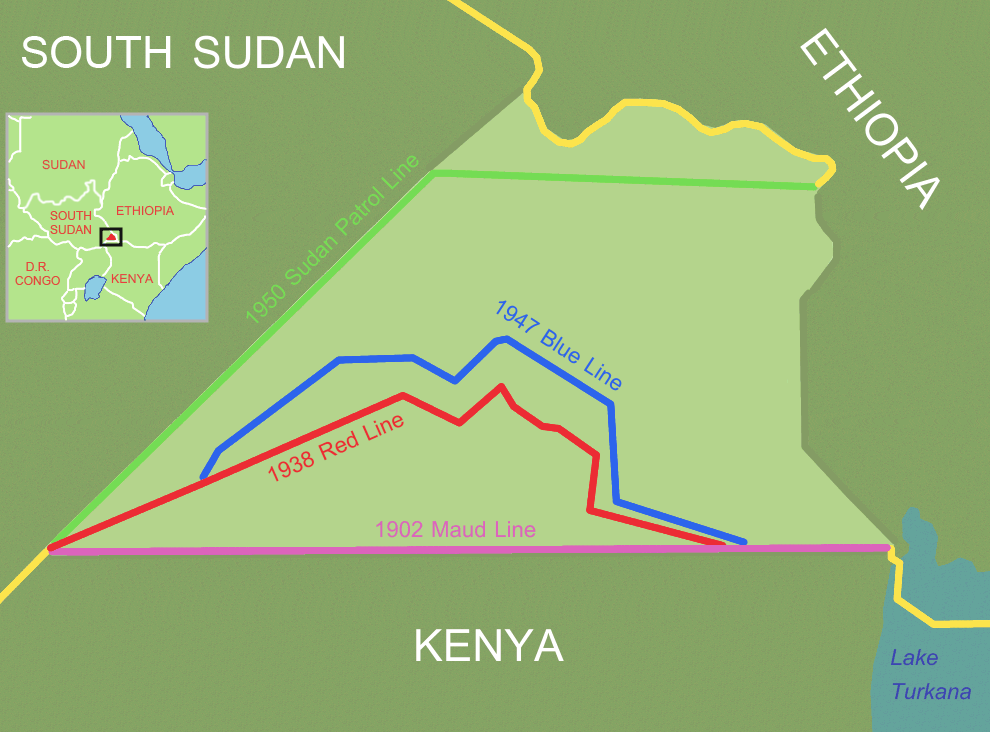
The Ilemi Triangle is a portion of land whose territorial ownership is contested by Kenya, South Sudan and Ethiopia. Its elastic size varies between 4,000 and 5,400 square miles, depending on the years and the surveyors. The triangle is mainly inhabited by the pastoralist communities of Turkana (from Kenya); Dassanech and Nyang’atom (from Ethiopia); and, Toposa (from South Sudan). In the heart of the triangle live the Turkana community particularly in areas of Kibish, Lokamarinyang’, Koyasa, Napak, Kokuro and Todonyang’. Surrounding them on the western side is the Toposa community from South Sudan who resides in Naita area; the Nyang’atom community who are found in the northeastern side in Kang’aten, Burme and Echoke villages; and the Dassanech community come out of the eastern side and reside in Koro, Nyemomeri, Damich, Salany and Sirimiriate villages. Of importance to note is that, the grazing patterns of these pastoralist communities exists independent of state borders hence their movement back and forth across the international borders of the three states.
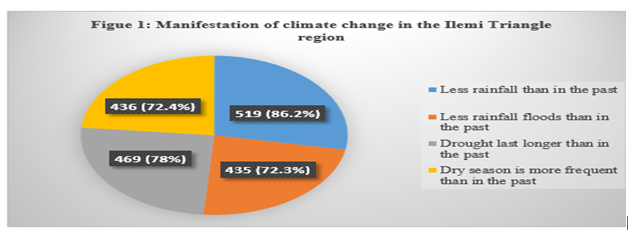
From Figure 1 above, it can be construed that this region suffers from high exposure to the negative effects of climate change as confirmed by the local communities. Vulnerability of pastoralism to these effects, therefore, work to increase climate-induced resource scarcity or abundance. With pastoral livelihood placing high demand on land, water and pasture, the pastoralist communities in this region are, therefore, extremely susceptible to these climatic changes and their corresponding effects. Increased in climate variability is a continuously decreasing herd size as a result of increased mortality rate and poorer reproductive performance of the livestock. During drought periods, the quality of grass is affected whereby the species of grass that grows with such little rainfall is not preferable for livestock consumption. As a result, a lot of livestock die due to lack of adequate and quality grass. The decrease in livestock numbers, therefore, affects food security and compromises the sole dependence of pastoralists on livestock and their products in this region.
As variability of rainfall in this area continues to be a reality and more livestock dying due to scarcity of water and pasture, some members of the Turkana and Dassanech communities are opting for fishing particularly in Lake Turkana, as an economic activity. However, the lake, which borders the Ilemi Triangle from the south east, is also experiencing the fluctuation in its water levels due to climate change. Furthermore, the water level of Omo River which gets its water from the Ethiopian highlands and empties it into Lake Turkana is also experiencing the same effect. The Turkana community living in Todonyang’ area (Kenyan side) depends on the water from the lake mainly for their livestock and fishing. The Dassanech community living in Koro area (Ethiopian side) depends on water from Omo River majorly for livestock, farming and fishing. Moreover, some members of the Dassanech community living in Sirimiriet village where the Omo River enters into Lake Turkana mainly depend on fishing in the lake. Furthermore, the Turkana and the Nyang’atom communities residing in Kibish and Kang’aten areas depend on the water from river Kibish (Nakuwa) for their livestock and small scale farming.
Interplay between climate change and inter-communal conflict in the region
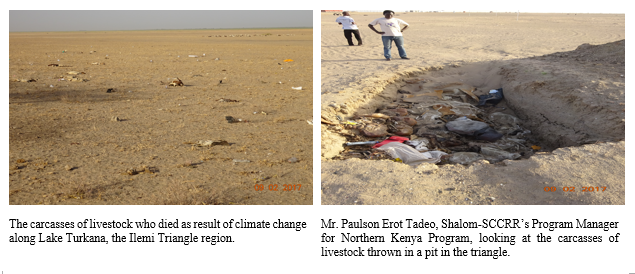
To explain the link between climatic factors and the occurrence of conflict in the context of the Ilemi Triangle region, two contrasting lines of argument are used herein – resource scarcity and resource abundance. However, the two theories both agree that climate change is a common factor when it comes to the understanding of inter-communal conflict and how the likelihood of climate change in the future could give an indication of the propensity for conflict among the pastoralist communities in this region.
a.) Resource scarcity
This theory argues that resource scarcity increases the likelihood of violence (Njiru, 2012; Doti, 2010; Omolo, 2010; Temesgen, 2010). Campbell et al. (2009) argues that ‘climate change is one of a range of factors causing natural resource scarcity, while natural resource scarcity is one of a range of factors causing conflict.’ In the context of the Ilemi Triangle, pastoralist communities potentially benefit from higher rainfall amounts as the availability of water and pasture for livestock increases. However, it does not only matter how much rainfall is received but also when it is received. Strong rainfall events followed by extended dry periods increase the likelihood of floods and droughts, especially in combination with the strong warming trend (Shalom-SCCRR, 2019; Williams & Funk, 2011).
It is important to note that drought is not a new phenomenon in this region. However, its frequency has steadily and surely increased over the last 15 – 20 years; and this increase gives pastoralist communities little time to recover from drought-related livestock losses (Shalom-SCCRR, 2019). Moreover, the increased intra-and-inter annual rainfall variability have decreased the predictability, reliability and availability of natural resources (mainly water and pasture) to these communities. This has, therefore, contributed to increased competition over scarce resources that generally lead to intensified inter-communal resource-based conflicts in this region.
As a result of the scarcity of water and pasture during periods of drought, there is often an increase in ‘climate change migration patterns’ (increase in the frequency of migration patterns than before) of the pastoralist communities – the Turkana, Dassanech, Nyang’atom and Toposa – along and across the international borders of Kenya, Ethiopia and South Sudan. These movements bring them into greater contact with each other causing increased competition over available scarce water and pasture for their livestock. This is when the communities become more conscious in regards to territorial ownership resulting to the increase in inter-communal conflicts related to boundaries.
During drought seasons when rainfall is low, the levels of water in Lake Turkana reduce significantly. As a result of this, availability of water for livestock for pastoralist communities both from the rivers and the lake becomes scarce. Places that were initially good breeding grounds for fish turn muddy due to increase in the rate of evaporation – this causes water to become more alkaline hence affecting the quantity and quality of fish in the lake. Consequently, the members of the Turkana and Dassanech communities who are fishermen move into deep waters to look for fish in different parts of the lake. This movement results in disputes over the few available fishing grounds where each community claims the ownership. This further contributes to inter-communal conflicts in the form of increased competition over fishing spots, stealing of fishing nets, and, retaliations in the grazing fields resulting to confrontation and revenge killings.
b.) Resource abundance
This theory suggests that more rainfall results in increased resource abundance or availability which in turn causes a higher level of inter-communal conflicts (Adano et al. 2012; Theisen 2012; Raleigh & Kniveton 2012). Theisen (2012), Adano et al. (2012), and, Raleigh and Kniveton (2012) find a positive statistical correlation between higher precipitation and violence among the pastoralist communities.
The resource abundance theory is still relevant in the context of the Ilemi Triangle region. Although it is true that there is frequency of droughts in this region, it is important to also note that when the rains arrive there is a relative increase in availability of vital natural resources, thus fueling an increase in inter-communal livestock raiding among the pastoralists in this region. During drought, pastoralists rarely engage in livestock raiding as they are too occupied with keeping their own livestock alive. In comparing violence during wet seasons against dry seasons, Shalom-SCCRR (2019) in its conflict analysis in this region found out that livestock raiding and other related violence increases during wet periods. This was in agreement with arguments by Witsenburg and Adano (2009) that livestock raiders like to attack more frequently during wet seasons because of the availability of plenty of grass, strong and healthy livestock, dense bushes to hide in and the availability of surface water which makes it easier for them to trek with raided livestock. According to this study, pastoralist communities often use traditional peaceful methods and governing institutions to work together, compromise and share scarce resources during times of drought (Witsenburg and Adano, 2009). However, cooperation becomes a less attractive option during the times of resource abundance since it is easier to engage in livestock raiding in order to ‘replenish and compensate’ the number of herds lost during drought seasons – a strategy for dealing with natural disasters, and a means for improving the quality and the number of the remaining livestock (herds).
Shalom-SCCRR intervention strategies in the region
In the context of Ilemi Triangle region, climate change is a common factor that contributes to inter-communal conflicts among the pastoralist communities as explained by both the resource scarcity and resource abundance theories in this paper. As a result of rainfall variability caused by climate change – during both drought and rainy seasons – the pastoralist communities in this region experience ‘climatic-induced’ inter-communal conflicts. In order to, therefore, intervene in addressing the conflicts among these communities, Shalom-SCCRR has continued to organize, strengthen and operationalize the local-based structures that are currently contributing to positive transformation through the implementation of key intervention strategies as discussed herein:
Capacity building of communities through peace trainings: Shalom-SCCRR has established organized local-based community peace groups whose membership constituted of key influential stakeholders in the form of local administrators (chiefs), elders, kraal leaders, youth leaders (warriors/morans), women leaders, security agents, religious leaders and representatives from NGOs/FBOs. So far, over 350 key influential community leaders have been taken through rigorous and contextualized trainings that have equipped them with analytical skills and techniques for conflict transformation and peacebuilding. The trained stakeholders are currently in the forefront in the implementation of the established and strengthened local-based conflict early warning and early response systems, and fostering inter-communal negotiation and dialogues in their communities. Through the utilization of this strategy, a number of conflicts have been addressed resulting in the return of raided and stolen livestock; increase in sharing of grazing fields and water points in Todonyang’ and Kibish areas; sharing of fishing grounds and return of stolen nets in Lake Turkana; and, improved inter-communal interactions through small-scale trading (fish business, motorbike transportation, mobile phones and foodstuff) in Omorate, Todonyang’ and Lowareng’ak areas.
Enhancement of inter-ethnic and inter-religious schooling: The organization is achieving this through the implementation of school educational and development projects in the form of construction and renovation of educational facilities (standardized classrooms, latrines and dormitories); and, supply of learning, teaching and boarding materials (desks, lockers, chairs, tables, stationeries, solar lighting systems, beds, mattresses and mosquito nets) to schools and other related institutions. The projects are directly benefiting over 7,000 learners and teachers in primary, secondary and tertiary institutions of learning, and indirectly benefiting a population of about 50,000 members of the pastoralist communities in Kenya, South Sudan and Ethiopia. These projects have contributed to the increased number of the pastoralist children accessing formal education; improved academic performance of pupils and students in the target schools; and, increased in the number of children from rival ethnic communities schooling and interacting with each other in supported schools.
Developing and nurturing a culture of peace and environmental security among school going children: In order to support the operationalization of peace education in schools in this region, the organization has established a number of peace clubs in the target schools. The teachers and children in these peace clubs have been taken through a series of peace trainings that have enhanced their capacities in fostering peaceful interaction and collaboration among pupils and students in their schools. Over 1,000 trained children (peace club members) and teachers (peace clubs’ patrons) are now spearheading intra and inter school peace debates, sports for peace, negotiations, dialogues and peace advocacy in the engaged schools. Consequently, there has been significant improvement in the interaction and collaboration among the pastoralist children in the target schools in the Ilemi Triangle region.
Important to note is that the engaged schools, through the guidance of Shalom-SCCRR are currently supporting the Sahel Great Green Wall Initiative (https://shalomconflictcenter.org/building-the-sahel-great-green-wall-in-the-face-of-localized-cross-border-conflict-how-shalom-sccrrs-peacebuilding-methodology-can-bear-on-the-conflict/) through their ‘Environmental Conservation Projects’ that advocates for the caring of ‘mother nature’ through initiatives such as the planting of trees, attending to soil erosion, hygiene and inter-communal collaboration in environmental management within the schools and surrounding villages.
Conclusion
Climate change is a contentious issue and not a deceptively simple knowledge area. This is partly because how it affects people’s health and livelihoods as well as interaction do not easily lend itself to direct observation. The effect of climate change on people may be in the form of an event or a process. Addressing climate change as an event or a phenomenon extending over a delimited time period may determine its effects better, as the case may be, than addressing it as a process. It is clear, however, that the long term changes in climate will most likely include an increase in drought frequency and intensity as well as an increase in rainfall variability. This variability will also include a short-to-mid-term increase in rainfall, which means heavier rainfall will possibly occur after periods of increased drought severity.
In the context of the Ilemi Triangle region, the linkages between climate change and inter-communal conflict is manifested through the competition over natural resources mainly pasture, water and livestock. Climate change altering the resource availability plays a role in the frequency and dynamics of inter-communal conflicts among the pastoralists in this region. It goes without argument that the projected climatic changes will continue to contribute to the increase of inter-communal conflicts among the pastoralist communities in this region. In order to save lives and livelihoods of these vulnerable communities, there is, therefore, need for Shalom-SCCRR, other relevant institutions (NGOs, FBOs and CBOs) and the concerned governments to intensify interventions in regards to conflict transformation, peacebuilding and environmental security in this region.
References
Adano et al. (2012). Climate change, violent conflict and local institutions in Kenya’s drylands. Journal of Peace Research, 49(1): 65-80.
Adhikari U., et al. (2015, June). Climate change and Eastern Africa: A review of impact on major crops. Available at: https://onlinelibrary.wiley.com/doi/full/10.1002/fes3.61
Campbell et al. (2009). Climate change and conflict-lessons from community conservancies in northern Kenya. Winnipeg: International Institute for Sustainable Development.
Conway G., and Schipper L. (2011, February). Adaptation to climate change in Africa: Challenges and opportunities identified from Ethiopia. Global Environmental Change, 21(1): 227-237.
Devine, P., (2009). Turkana – Dassanech conflict: Causes and Consequences. (Unpublished master’s dissertation). Hekima Institute of Peace Studies and International Relations (HIPSIR), Catholic University of Eastern Africa, Nairobi, Kenya. Available at:
http://hipsir.hekima.ac.ke/images/stories/downloads/Newsletters/Peace-Dialogue-Issue-19.pdf
Doti T., (2010). Climate Variability, Pastoralist’ Vulnerability and Options. In D. Mwitu-rubani & J. A. van Wyk (Eds). Climate change and natural resources conflicts in Africa. Pretoria: Institute of Security Studies.
Herrero, M. et al. (2016). Climate change and pastoralism: Impacts, consequences and adaptation. Available at: https://pubmed.ncbi.nlm.nih.gov/27917982/
Huang et al. (2016, July). Dryland climate change: Recent progress and challenges. Available at:
https://agupubs.onlinelibrary.wiley.com/doi/full/10.1002/2016RG000550
IPCC (2018). Climate change impacts worse than expected. Available at:
Ngacha, A. M., (2020). Diminishing role of traditional mechanisms in the management of pastoralist conflict: An Analysis of Turkana-Dassanech conflict. Available at: https://shalomconflictcenter.org/briefing-paper-no-2-an-analysis-of-turkana-dassenach-conflict/
Njiru B. N., (2012). Climate Change, Resource Competition and conflict amongst pastoral communities in Kenya. In J. Sheffran, M. Brzoska, H. G. Brauch, P. M. Link & J. Schilling (Eds). Climate Change, Human Security and Violent Conflict: Challenges for societal stability. Berlin: Springer.
Omoka W. K., et al. (2020). A Proposal by Shalom-SCCRR for Conflict Transformation around the Building of the Sahel Great Green Wall. Available at: https://shalomconflictcenter.org/building-the-sahel-great-green-wall-in-the-face-of-localized-cross-border-conflict-how-shalom-sccrrs-peacebuilding-methodology-can-bear-on-the-conflict/
Omolo, N.A., (2010). Gender and Climate Change-induced conflict in pastoral communities: Case Study of Turkana in northwestern Kenya. African Journal on Conflict Resolution 10(2): 81-102
Raleigh C., and Kniveton D., (2012). Come rain or Shine: An Analysis of conflict and climate variability in East Africa. Journal for Peace Research, 49(1): 51-64.
Shalom-SCCRR (2019). Changing Conflict Dynamics among Pastoralist Communities along Kenya – Ethiopia borderline: A critical Analysis. Unpublished manuscript.
Temesgen A. K., (2010). Climate Change to Conflict? Lessons from Southern Ethiopia and Northern Kenya. Oslo: Fafo.
Theisen O. M., (2012). Climate Clashes? Weather Variability, Land pressure and organized violence in Kenya, 1989-2004. Journal of Peace Research, 49(1): 81-96.
Williams A., and Funk C., (2011). A westward extension of the warm pool leads to a west-ward extension of the Walker circulation, drying Eastern Africa. Climate Dynamics, 37(11): 2417-2435.
Witsenburg K. M., and Adano W. R., (2009). Of Rain and Raids: Violent livestock raiding in northern Kenya. Civil Wars, 11(4): 514-538.
By;
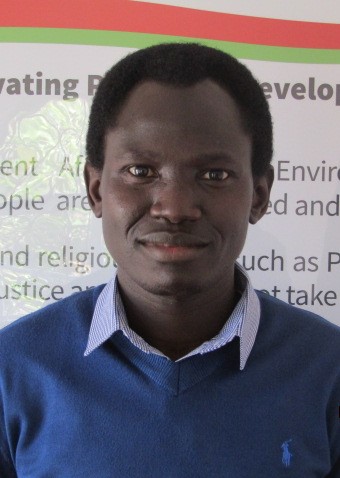
Paulson Erot Tadeo, MA.
Program Manager (Peacebuilding & Development), Northern Kenya Program,
Shalom Center for Conflict Resolution and Reconciliation.

